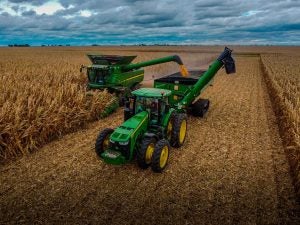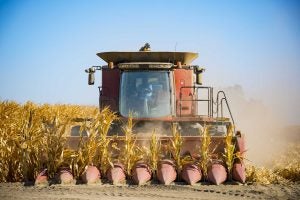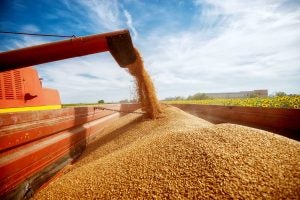Did you know that field corn can be found in over 4,000 items in the grocery store? Not only is a small portion of it used in food products like chips and cereal and such, but it’s also common in everyday products like shampoos and toothpaste — and even in the cardboard boxes many products come in. Much of field corn — recognizable by the classic big ears and distinctive dent that forms on the kernel as the corn dries — is used in ethanol production and as livestock feed. The United States uses so much field corn that farmers plant about 30 million acres of the crop across the nation each year.
Below, we’ll take a look at the unique way we get that corn from the field into the products you use every day.

Field corn is commercially harvested using a massive piece of machinery, called a combine. (Combines got their name because they combine the functions of harvesting, threshing, and cleaning the kernels.) Combines of some form have been used since the 1800s. This machine makes harvesting field corn an incredibly efficient process compared to the previous methods of hand harvesting and processing.
A corn combine can process about 200 acres of field corn each day, which is important as corn needs to be harvested at a certain moisture content for proper storage.
The front of the machine is the start of the process, this is called the header.

The header, pictured above, has many ‘torpedo’ like attachments on the front, which go in between the corn rows and separate each row evenly as it feeds the individual stalks into cutting rollers. This cutting bar chops the stalks low to the ground, and also pulls (or rolls) the stalks into the machine to begin the threshing process. The header is in charge of the initial function of a corn combine, harvesting.
Once the corn is pulled into the machine it comes in contact with the stalk auger. This auger moves the stalks after they have been cut into the heart of the machine, the threshing cylinder. The threshing cylinder is where most of the action occurs in the machine. This cylinder rotates at a high rate of speed, removing the ears of corn from the stalk and the grain kernels from the ear in the same process. The stalks of the plant are caught up in the augers and transported to the back of the machine via straw walkers, eventually the stalks are expelled out of the back of the machine.
Leaving the vegetative plant parts in the field helps increase organic matter content in the soil and returns nutrients to the ground as the plant breaks down.
The threshing cylinder sits above a concave trough with slits in it. As the cylinder contacts the ears of corn it shakes loose the grain kernels, while simultaneously removing the husk. All of this plant materials falls into the concave where various sieve levels vibrate, allowing the kernels to fall through and the larger plant materials to stay at the upper levels. This plant material is called the “chaff.”
A fan sits in these upper levels and blows the light weighted chaff out of the back of the machine, joining the stalk parts on the ground. Some corn ears may make it into the concave without the kernels being removed, these are recirculated back to the threshing cylinder via an auger into the “tailings elevator,” where they will be broken up and the grain kernels removed.
The grain kernels that fall through the vibrating sieves are caught in a grain auger which transports them to the grain holding tank. A grain holding tank can hold over 400 bushels of corn before it needs to be removed and placed into a trailer. Of course, every combine model will have different features and holding capacities. An unloading auger is used to pull the corn kernels from the holding tank out and into a waiting trailer.

This process happens incredibly fast while the combine moves through the field. In fact, in most situations the combine doesn’t even stop to unload the corn in it’s holding tank. A tractor or semi will pull up next to the combine while it continues to harvest and the combine driver will extend the unloading auger out over the neighboring trailer and unload the holding tank while they drive next to each other through the field.
After field corn is harvested and unloaded into trailers it will be unloaded via another auger into a grain bin. Sometimes corn can be harvested when it is still too wet and in that case it needs to be sent to a corn dryer, which will heat the corn to remove moisture so it can be stored without worry of mold growth. Wet corn is dangerous corn as it can increase the breakdown of materials, which generates heat — and if enough heat is generated the bin can spontaneously combust.
Next time you are enjoying a corn tortilla, or brushing your teeth, or even opening the latest Amazon box, remember the amazing piece of technology that helped a farmer get the field corn from the farm to your table.
Michelle Miller, the Farm Babe, is a farmer, public speaker and writer who has worked for years with row crops, beef cattle, and sheep. She believes education is key in bridging the gap between farmers and consumers.



